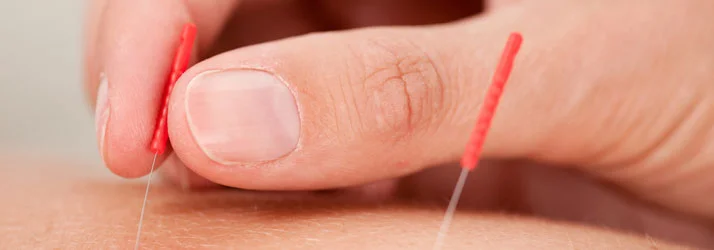Dry Needling In Loveland OH

What Is It?
Questions about dry needling in Loveland OH? Dry needling refers to the insertion of thin monofilament needles, as used in the practice of acupuncture, without the use of medication. Dry needling is typically used to treat muscles, ligaments, tendons, subcutaneous fascia, scar tissue, peripheral nerves, and neurovascular bundles for the management of a variety of neuromusculoskeletal pain syndromes.
What Does Dry Needling Treat In Loveland OH?
Dry needling has proven effective in alleviating many conditions including:
- Back Pain: including lumbar degenerative disk disease, arthritic changes, and herniated discs
- Neck Pain: whiplash, headaches, degenerative joint disease, degenerative disk disease or osteoarthritis
- Dental (Teeth) and Orthodontic (Jaw and Occlusal) Pain: including temporomandibular joint (TMJ) dysfunction
- Shoulder Pain: including rotator cuff muscle tears, bursitis, adhesive capsulitis (frozen shoulder), tendonitis, and impingement syndrome
- Elbow Pain: including lateral epicondylitis (tennis elbow) and medial epicondylitis (golfer’s elbow)
- Hand and Wrist Pain: including gamekeeper’s thumb, DeQuervain’s syndrome, carpal tunnel syndrome, degenerative joint disease, and osteoarthritis
- Hip Pain: including degenerative joint disease, and osteoarthritis
- Knee Pain: including degenerative changes or osteoarthritis
- Shin/Ankle/Foot Pain: including shin splints, metatarsalgia and Morton’s Neuroma
- Plantar Fasciitis (Heel Pain)
- Acute and Chronic Tendonitis
- Post- Post-surgical pain Athletic and Sports-related Overuse Injuries
- Post-Traumatic Injuries, Car Accidents, Work-related Injuries
- Other Chronic Pain Conditions: including myofascial pain and myofascial pain syndrome (MPS)
Generally, patients can expect to see positive results from dry needling after 2 to 4 sessions.
How Does Dry Needling Relieve Pain?
The precise mechanism that makes dry needling an effective intervention for musculoskeletal pain remains unknown. Nevertheless, several theories have been formulated to explain its effectiveness by examining the response of the neuromuscular system to the introduction of a needle into the body. There are 3 types of responses: mechanical, chemical, and neurophysiological (having to do with the functions of the nervous system).
- MECHANICAL THEORY: Mechanically, when a needle is inserted into the body, it damages tissue, creating a controlled lesion. The body then produces an inflammatory response to this lesion and immediately begins to work to repair the damaged tissue as well as any previous lesions in the area.
- CHEMICAL THEORY: Dry needling has been shown to increase the number of chemicals at the nerve endings. The release of some of these chemicals is thought to overstimulate the nerve. The hyperexcited nerve then elicits a local twitch response (LTR) from the muscle —a visible, involuntary spinal cord reflex in which the muscle fibers contract and cause a sensation much like a brief cramp. The LTR works to stabilize or reset the chemical balance at the nerve ending, causing any spontaneous electrical activity to subside. This in turn “resets” the muscle and releases the local trigger point
- NEUROPHYSIOLOGICAL THEORY: From a neurophysiological standpoint, dry needling has been shown to facilitate the release of chemicals that mediate the transmission of pain signals. Most likely, as it elicits LTRs, dry needling also activates the body’s production of endogenous opioids or pain-relieving, sleep-inducing substances, such as endorphins.
OFFICE HOURS
Monday
8:30am - 5:30pm
Tuesday
9:00am - 6:00pm
Wednesday
9:00am - 6:00pm
Thursday
8:30am - 5:30pm
Friday
Closed
Saturday
Call the office for available Saturday hours
Sunday
Closed
Living with Motion Chiropractic
6355 Branch Hill-Guinea Pike
Loveland, OH 45140



